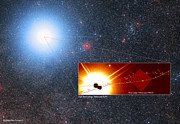Tiedote
Alpha Centaurin tulevaisuus
Vuonna 2028 on harvinainen tilaisuus planeetan etsimiselle Alpha Centauri A:n ympäriltä
20. lokakuuta 2016
Hyvin harvinaisen gravitaatiolinssi-ilmiön on ennustettu tapahtuvan vuonna 2028. Sen on ennustanut ranskalaisten tähtitietelijöiden tiimi, mitä Pierre Kervella (CNRS/Universidad de Chile) johtaa. Se antaa erinomaisen mahdollisuuden planeetan etsimiseksi lähitähden ympäriltä.
Käyttämällä sekä arkistodataa, että uusia ESO:n teleskooppien [1] havaintoja, ryhmä on ennustanut radan tunnetulle kaksoistähti Alpha Centauri A ja B:lle erittäin suurella tarkkudella. Se on mahdollistanut Alpha Centauri parin ja läheisten tähtien välisen näennäisen lähietäisyyden (todellisuudessa ne ovat hyvin kaukana toisistaan avaruudessa) ennustamisen vuoteen 2050 saakka [2].
Vaikka tulevaisuuteen näkeminen tällaisella tarkkuudella onkin kiehtovaa, niin se ei kuitenkaan ole näiden tulosten tärkein palkinto, vaan ne antavat ainutlaatuisen mahdollisuuden planeettojen metsästämiselle Alpha Centauri systeemistä, sillä nämä tulokset mahdollistivat sekundaaristen gravitaatiolinssitapahtumien tutkimisen. Gravitaatiolinssi-ilmiö tapahtuu, kun massiivinen kohde, kuten tähti vääntää ympärillään olevaa avaruutta. Kaukaisesta kohteesta tuleva valo, mikä kulkee tähden läheltä meitä kohti, seuraa kaareutuvaa rataa seuraten vääntynyttä avaruuden geometriaa. Lähempi tähti toimii linssin tavoin ja taivuttaa kaukaisemman tähden valon kulkua. Kaikkein vaikuttavimissa tapauksessa tämä voi saada aikaan Einsteinin renkaan, mikä on valorengas lähempänä olevan tähden ympärillä. Koska tämän lähitähden massa määrittää tarkasti miten tämä valon taipuminen tapahtuu, niin poikkeamat tästä ennustetusta gravitaatiolinssiefektistä määrittävät mahdollisten planeettojen olemassaolon ja massat.
Yksi jännittävimmistä tämän tutkimuksen ennustamista lähikohtaamisista tapahtuu Alpha Centauri parin massiivisemman tähden, eli Alpha Centauri A:n ja kaukaisemman mahdollisesti punaisen jättiläistähden nimeltään S5:n kanssa. Toukokuussa 2028 on suuri mahdollisuus siihen, että S5:stä tuleva valo aiheuttaa Einsteinin renkaan Alpha Centauri A:n ympärille, mikä on havaitavissa ESO:n teleskooppien avulla [3]. Tämä antaisi ainutkertaisen mahdollisuuden planeettojen tai muiden pienimassaisten kohteiden etsimiselle meitä lähimmän tähtijärjestelmän ympäriltä. Tämä on erityisen jännittävää äskettäin löydetyn planeetta Proxima b:n valossa, mikä on saman tähtisysteemin kolmannen tähden, eli Proxima Centaurin planeetta.
Lisähuomioita
[1] Valtavien etäisyyksien vuoksi useimpien tähtien todellisten liikkeiden mittaaminen on äärimmäisen vaikeaa ja se vaatii uskomattoman tarkkoja mittauksia, sekä hyvin kattavia havaintoja. Tähtitietelijöiden joukko käytti vuonna 2007 tehtyjä havaintoja New Technology Telescope, eli NTT-teleskoopilta ja uusia NACO-instrumentin havaintoja Very Large Telescope eli VLT-kaukoputkelta. Näitä täydensivät Atacama Large Millimeter/submillimeter Array eli ALMA:n havainnot, joiden avulla saatiin erittäin tarkkoja havaintoja Alpha Centauri A:n ja B:n suhteellisista paikoista.
[2] Koska Alpha Centauri systeemi sijaitsee lähellä Linnunradan tasoa, on sillä alueella tähtiä hyvin paljon ja tämä antoi ryhmälle hyvän mahdollisuuden löytää taustatähti, mikä olisi lähes täysin samassa suunnassa kuin Alpha Centaurin kaksoistähtipari.
[3] Tapahtuma on havaittavissa GRAVITY-instrumentilla "Very Large Telescope Interferometer":lla, Atacama Large Millimeter/submillimeter Array eli ALMA:lla, sekä tulevalla European-Extremely Large Telescope, eli E-ELT-kaukoputkella, mitkä tekevät minkä tahansa massaisen planeetan havaitsemisen mahdolliseksi erittäin suurella tarkkuudella.
ALMA on kansainvälinen tähtitieteen tutkimusyksikkö ja se on kumppanuushanke ESO:n, U.S. National Science Foundation, eli NSF:n ja Japanin National Institutes of Natural Sciences, eli NINS:in välillä yhdessä Chilen tasavallan kanssa.
Lisätietoja
Tämä tutkimus julkaistiin 19.10.2016 Astronomy and Astrophysics julkaisussa (Kervella et al. 2016, A&A, 594, A107)
Ryhmä koostuu seuraavista tahoista: P. Kervella, CNRS UMI 3386, University of Chile ja LESIA, Paris Observatory; F. Mignard, Côte d’Azur Observatory, Ranska; A. Mérand, ESO; ja F. Thévenin, Côte d’Azur Observatory, Ranska.
Linkit
Yhteystiedot
Richard Hook
ESO Public Information Officer
Garching bei München, Germany
Puh.: +49 89 3200 6655
Matkapuhelin: +49 151 1537 3591
S-posti: rhook@eso.org
Pierre Kervella
Departamento de Astronomía, Universidad de Chile
Camino El Observatorio 1515
Las Condes
Santiago, Chile
S-posti: pkervell@das.uchile.cl
Frédéric Thévenin
Observatoire de la Côte d'Azur
Boulevard de l’Observatoire
Nice, France
S-posti: Frederic.Thevenin@oca.eu
Puh.: +33 4 92 00 30 26
Tiedotteesta
| Tunnistus: | ann16075 |

